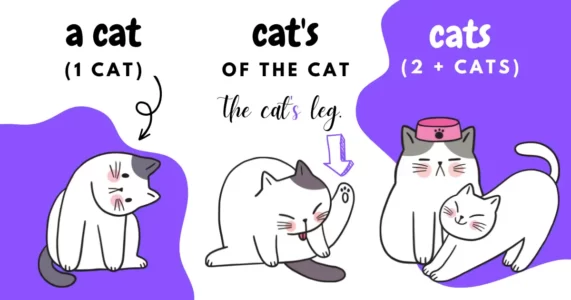English verbs are not as complicated as many learners think. Specifically, when it comes to verb conjugation, as you will see below, they tend to be much easier than verbs in some other languages. That is not to say that there are no challenges whatsoever.
In this section, the focus is on action verbs. The verb to be deserves its own section and will not be talked about here. Also, I will not go into the details of all tenses mentioned here but you will find links to other pages that deal with that, if available.
Check the Table of Contents to jump to a section that interests you the most if you don’t feel like reading through the whole thing .☺️

1. Verb Conjugation
In English, as in most languages, verbs have base forms. The base form of the verb (sometimes called bare infinitive, or root – without to in front) is the form that appears in dictionaries.

To be able to use the dictionary form of verbs with different personal pronouns, we need to conjugate the verbs, which means that we need to change their endings.
The good news is that there are fewer difficulties with verbs in English in comparison with other languages when it comes to verb conjugation.
1.1 Present Simple Tense
As opposed to English, in other languages, verbs may have different endings for each (or most) of the personal pronouns, as shown in the examples below.
(There is no need to speak any of the languages used in the comparison. The point is to notice how simplified English is when compared to the other languages.)

Some more examples include:
Finnish
- Minä laulan
- Sinä laulat
- Hän laulaa
- Me laulamme
- Te laulatte
- He laulavat
Bulgarian
- Аз пея
- Ти пееш
- Той/Тя/То пее
- Ние пеем
- Вие пеете
- Те пеят
As you can see from the comparison above, all the languages, except English, have different verb endings for each of the personal pronouns. That effectively means that, in English, there is no need to memorize so many different endings. In the case of the Present Simple Tense, all you need to do is to add -s/-es to the end of the verbs for the 3rd person singular he, she, and it (formula below.) For the rest of the pronouns, the verb doesn’t change.
Language math ☺️
- to work: work + s = works
- to dance: dance + s = dances
- to go: go + es = goes
- to study: study (y ➡️ i) = studi + es = studies
- Kai works in a supermarket and studies Communications.
- Ana goes to ballet school and dances beautifully.
1.2 Past Tenses
Here comes something else which is easy to remember: the forms of action verbs for past tenses do not change. Unlike many other languages, in English, they stay the same for all personal pronouns. Let’s take the action verb to ask in both English and Finnish to illustrate.
English
- I asked
- You asked
- He/ She asked
- We asked
- You asked
- They asked
Finnish
- Minä kysyin
- Sinä kysyit
- Hän kysyi
- Me kysyimme
- Te kysyitte
- He kysyivät
The above example uses the past form of the verb to ask (asked), which is a regular verb, to show that, in English, the verb doesn’t change when used with different personal pronouns. The same past form is used with all pronouns, whereas, in the Present Simple Tense, the verbs needed an additional -s/-es for the 3rd person singular he/ she/ it.
That’s the easy part. The hard part is to remember which are regular and which are irregular verbs in English. The following sections focus on that.
2. Verb types and verb forms
We use the Present, Past, and Past Participle verb forms to express different things. The Present verb form is used to talk about things that are happening now. The Past and Past Participle forms help us talk about things that happened or started in the past.
2. 1 Regular Verbs
When it comes to tenses, there are two types of verbs – regular and irregular. The difference between the two is the types of endings these verbs have for their past and past participle forms.
To start off, let’s have a look at the rule we need to follow when forming the Past and Past Participle. It’s fairly simple.

As can be seen above, we add endings only to regular verbs. We do not add any endings to irregular verbs because they have their own forms.
Sometimes it’s possible for some regular verbs to have the so-called *t variant. For example, to dream and to learn are two such verbs.
- to dream: dream + ed = dreamed [driːmd] or dream + t = dreamt [drɛmt]*
- to learn: learn + ed = learned [ləːnd] or learn + t = learnt [ləːnt]
There are some additional rules to forming the Past and Past participle forms of regular verbs, and some exceptions as well, but that is not the focus of this post.
Anyway, the endings for the Past and Past participle forms of regular verbs are the same. Let’s have a look at the regular verbs to smile, and to work:
| Present | Past | Past participle |
| smile work | smiled worked | smiled worked |
If there are the same, then why is it important to make the distinction?
As shown below, we need the Past form for the Past Simple Tense, which is used to talk about things that happened at a specific time in the past (in 1985, 3 years ago, last week, yesterday, this morning, etc.)
The Past Participle form is used, for example, with the Present Perfect Tense, to talk about things that started at some point in the past but are still happening today or are still true today.
To be able to use the Present Perfect Tense correctly, remember to add have (or has for the 3rd person singular) before the Past Participle form of the verb.

For the 3rd person singular, the above sentences look like this:
- She moved to Spain in 2012. (Past form)
- She has lived in Spain since 2012. (Past participle)
2. 2. Irregular verbs
It has become clear that to form the Past and Past Participle of regular verbs, we add -ed or -d to the end of verbs. It’s a simple rule to remember. However, other than the fact that we do not add any endings to irregular verbs, there are no specific rules for their formation, and neither is there a way to tell which verbs are regular and which ones are irregular. Therefore, the best way to go about it is to memorize irregular verbs as they come.
Even though there are no specific rules to help us form irregular verbs, they can be divided into four separate categories. I will also try to find similarities within the categories so that it is easier to see the patterns.
- Irregular verbs that have the same Present, Past, and Past participle forms
These come as number one because they are the easiest to remember.
| Present | Past | Past participle |
| cut put let set | cut put let set | cut put let set |
It could be said that the pattern here is that many of the verbs in this category are one-syllable words. Of course, there are exceptions. For example, get-got-gotten. Here are some examples of usage:
- I cut my finger yesterday but it’s looking better today.
- I have cut vegetables before, I know what I’m doing.
2. Irregular verbs that have different Present forms but the same Past and Past participle forms
| Pattern | Present | Past | Past participle |
|---|---|---|---|
| EEP ➡️ | sleep weep keep | slept wept kept | slept wept kept |
| I ➡️ OU | find grind bind | found ground bound | found ground bound |
| END➡️ENT | spend lend send | spent lent sent | spent lent sent |
| Other similar verbs | buy teach feel | bought taught felt | bought taught felt |
Here are some examples to illustrate the usage:
- I slept well last night. I have a lot of energy today.
- I am so tired, I haven’t slept in days.
3. Irregular verbs that have the same Present and Past participle forms, but а different Past form
| Present | Past | Past participle |
|---|---|---|
| come become overcome | came became overcame | come become overcome |
- Edward VI became king at the age of nine.
- I‘ve come to apologize.
4. Irregular verbs that have completely different forms for all three Present, Past, and Past participle forms.
These irregular verbs come last on the list because they are usually the hardest to remember, and can be quite confusing.
| Present | Past | Past participle |
|---|---|---|
| do see begin | did saw began | done seen begun |
- I didn’t eat the cookies! He did!
- I have seen this movie before. I don’t like it.


